Plant-Based Leather Alternatives: Comparing Sustainability and Performance
Written by Tirsa Parrish and Jet Thurmond
The fashion industry has reached a time of unprecedented potential in technological advancement. These advancements have the capability to foster change within the industry and beyond in the world of sustainability. Sustainability is just a buzzword for some brands and greenwashing of products and procedures is problematic. Companies are marketing products as sustainable alternatives even if they are not not 100% eco-friendly. Non-animal leather alternatives are being released faster than ever, but it is important to determine which ones are truly created consciously.
Non-animal leather is a material that mimics leather, but it is created from synthetic or plant-based materials rather than animal skin. While widely used, it is important to recognize that the term “vegan leather” can be a bit misleading. Vegan prioritizes the absence of animal based products or ingredients but this does not mean the product is environmentally friendly.
Some consumers may prioritize the lack of animal products over sustainability, but Lucrezia Bernardi from Maker’s Valley puts it best: “Cruelty free doesn’t always equal chemical free.” While both are technically vegan, we will create a distinction by referring to petroleum-based leathers as synthetic leathers, and plant or fungi based alternatives will be referred to as non-animal leathers.

Image via btod.com
The Benefits And Drawbacks
There are benefits to utilizing leather alternatives. As a market capable of exponential growth, the synthetic leather materials market was valued at $16.5 billion in 2022 and is expected to reach almost $22.6 billion by 2030. The lowered cost of production makes this product appealing for a wide variety of uses.
Synthetic leathers are also much easier to finish in multiple ways, which makes it more versatile for a variety of end uses. Synthetic and non-animal leathers are not as strong or durable as leather, and initially they look very similar to leather.
However, when they start to degrade they will eventually begin to crack, peel, which is not easily repairable. The need to repeatedly replace these items is a factor to consider as non-animal leather is traditionally much thinner and less durable so you may only get a year or so out of an item.
Animal leathers do not age the same as synthetic leathers. Animal leathers become softer and ‘break in’ with time from wear and will naturally patinate, and many believe that they look better with age. Properly maintained traditional leather can last for decades. Animal leather also possesses a unique breathability that many synthetic leathers are not capable of recreating.
Leather tanneries may use chromium sulfate, a salt that is harmful to the environment and exposure is hazardous to one's health. The leather industry is working hard to improve their methods, thanks in part to enforced government regulations and initiatives of the Leather Working Group.
The most common alternative to animal leather at present is synthetic leather. These can be produced by several methods but all of them include the use of plastics derived from petroleum, a fossil fuel. A current processing method for synthetic leather is using embossed release paper (casting paper) as a form for the surface finish, meant to mimic a top-grain leather.
First, the release paper is coated with several layers of plastic like polyvinyl chloride (PVC) or polyurethane (PU), possibly including a surface finish, color layer, foam layer, adhesive, fabric layer, and reverse finish. The synthetic leather is cured and release paper is removed and possibly reused.
There are some historic methods as well, such as leatherette, which involves covering a fabric base with plastic. Made of natural or synthetic fiber, covered in a soft PVC layer, leatherette was often used in bookbinding and it was common on castings in 20th century cameras.
New technological developments have allowed for the development of leather alternatives derived from natural sources. While none are perfect, they all can aid in reducing the waste that occurs from traditional agricultural methods.
The market for non-animal leathers is also expected to rise to almost $97 million by 2027. Almost all non-animal leathers including plant based during the manufacturing processes include a non-biodegradable coating or sealant. This means that although a large percentage of the material may be bio-based, the product itself is not biodegradable. Here are a few non-animal leather alternatives that have emerged.
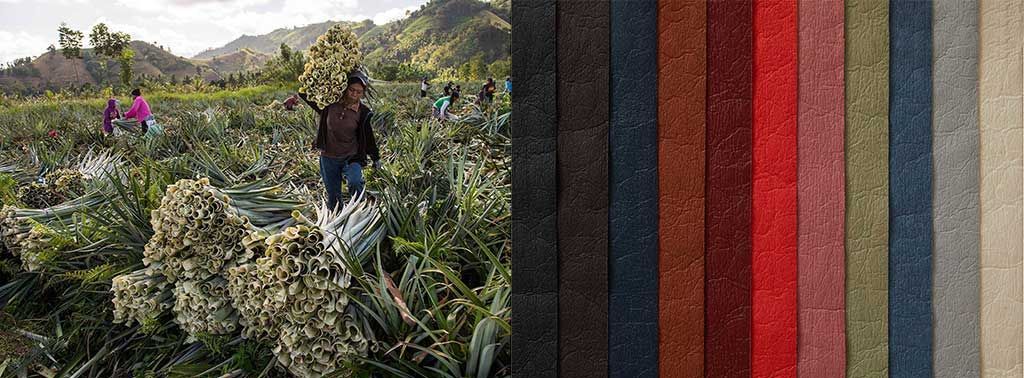
Left: Pineapple lead collection, Right: Pinatex in various colors. Images via ananas-anam.com
Pineapple leather, called Piñatex, is manufactured and distributed exclusively by Ananas Anam, LTD. It is produced by felting the long fibers from pineapple leaves together to create a non-woven substrate.
It is then combined with Polylactic Acid (PLA), a vegetable-based plastic material derived from cornstarch. The material is coated with petroleum-based resin afterward. Around 480 leaves are needed to produce 11 square feet (or 1 square meter) of material.
There are several advantages to Piñatex. This non-animal leather utilizes waste pineapple leaves and the pineapple industry produces 40,000 tons of waste leaves each year. Typically, many are left to rot or be burned. Leftover biomass from Piñatex production can be used as a fertilizer. The conversion of waste into non-animal leather can also provide additional income for farmers.
The process uses no additional water, pesticides or fertilizers, and does not require the tanning process needed with traditional leather. According to Ananas Anam, the overall ecological impact of pineapple leather is almost 2/3 less than synthetic leather. However, in order to achieve necessary durability and a consistent feel, Piñatex has a polyurethane resin coating. With this petroleum-based resin, the product is not biodegradable.
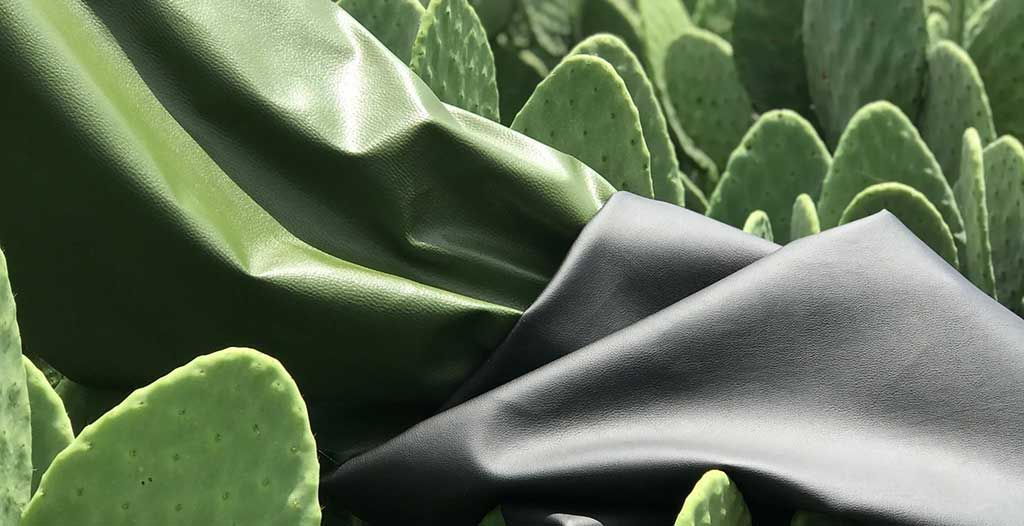
Cactus leather: Image via desserto.com.mx
Cactus leather is produced from the nopal cactus, also commonly called the prickly pear or Indian fig opuntia. It is only manufactured by Desserto at present. To produce this non-animal leather, the cactus is harvested about twice a year by cutting off only mature pads (cactus leaves) so that the cactus isn’t damaged and can continue to grow.
Pads are cleaned, smashed into smaller pieces, and put in a solarium to air-dry for three to five days. Fibers are then separated and pulverized, a powdered protein is extracted, sent to a laboratory, and mixed with other ingredients to create a liquid bio-resin. The resin is poured on top of a carrier material to form cactus leather. The type of material used is dependent on the future textile application.
Cactus leather is unique in the non-animal leather market because of its breathability. Desserto has collaborated with several brands such as Givenchy, Fossil, Adidas, and Mercedes-Benz to supply them with cactus leather for collections. If more cactus pads are harvested than needed for non-animal leather production, they are simply shipped to the market to be sold as a common food.
There are many positives that promote the use of cactus leather. For example, the cactus used is fast growing and is not heavily reliant on water or pesticides for survival. It is adaptable and hard to kill.
Cacti have the ability to sequester carbon, which means carbon dioxide is pulled out of the atmosphere and stored in the plant. Cacti traditionally do a better job of keeping carbon in the soil and out of the air. Desserto claims it is comparable to animal leather in longevity, and it can be chemically or mechanically recycled.
However, polyurethane is used in the resin formula making cactus leather non-biodegradable. There are also negatives from an environmental perspective. Being adaptable and hard to kill have made cacti an invasive species in non-native areas. Nearby land used for farming other crops can be overrun and become unusable. However, responsible farming practices can strongly mitigate this problem.
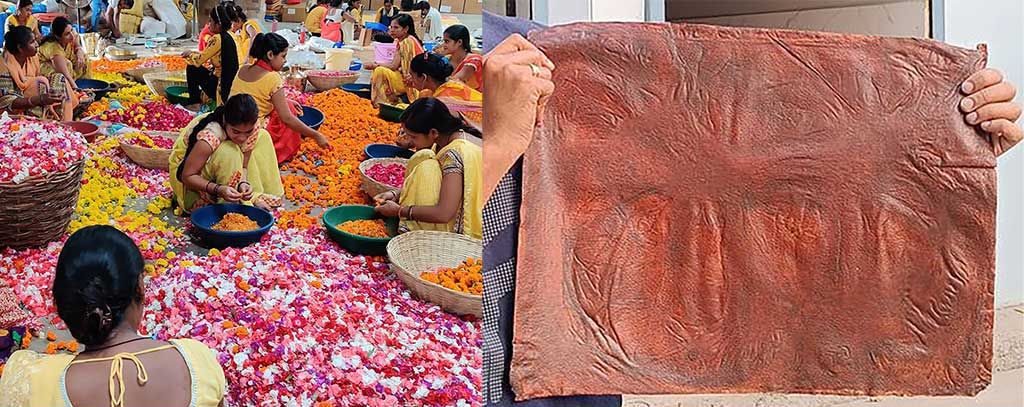
Left: Women separating flowers by variety and removing petals. Image via townandcountrymag.com; Right: Finished sheet of fleather, image via bbc.com
Fleather is another alternative that was created to solve India’s flower waste problem. Ankit Agarwal founded his start-up, Phool (meaning ‘flower’ in Hindi), in an effort to stop the Ganges River from becoming a dumping ground for over 8 metric tons of toxic floral waste daily.
The non-animal leather was facilitated by PETA India, and it is created from the immense amount of flower waste from temples and mosques. Since 2015, more than 11,060 metric tons of flower waste have been collected every day from temples and mosques and is used to create other flower-based items such as a clean-burning incense and biodegradable packaging used as a replacement for styrofoam.
Fleather was created completely by chance. Scientists noticed that the unused flower fibers had a dense and fibrous mat growing on top that was similar to the look, feel, and strength of leather. This was a fungal microorganism growing on the flowers, similar to mushroom roots.
Production officially began in 2021. The flower petals used to make Fleather are broken down by hand. The scientists prepare a flower-based nutritive substrate, ‘Fleather food,’ over which organisms grow and interconnect.
The result is a leather-like product. It is then tanned with a tree bark powder solution, dried, dyed, and embossed with a snake or crocodile pattern. While it has gained a lot of traction, the original manufacturing plant only has the capacity to produce about 9,000 square feet of leather a month. This is enough to produce about 2,200 wallets.
Fleather is 100% biodegradable and is also more breathable than other alternatives because it does not use a petroleum-based sealant. Unfortunately, this currently comes with the cost of lower tensile strength making it not-yet-suitable for items that require more toughness like belts.
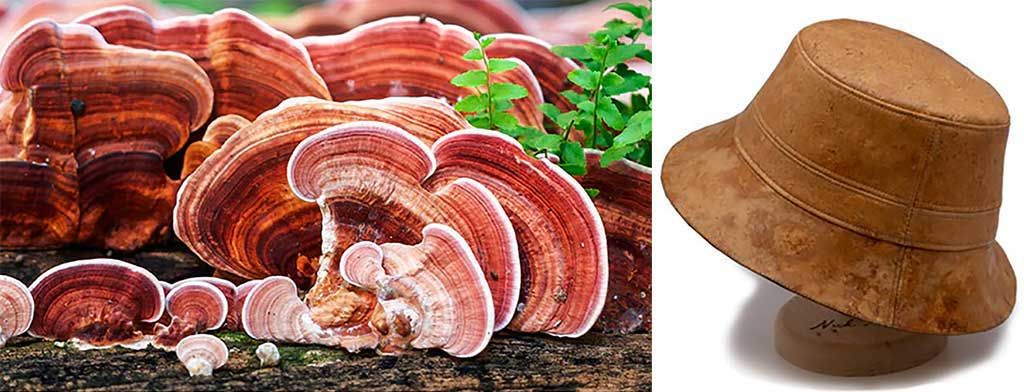
Left: Ganoderma lucidum (reishi) mushrooms. Image via su.atpscience.com; Right: Reishi Boletus hat. Image via prnewswire.com
Mushroom leather uses mycelium, the equivalent to a root structure of mushrooms, to make a leather-like substance. It has the look and feel of traditional leather, and it is a leading contender in the market of leather replacements.
It can currently be produced in sheets of six square feet. It is produced by several manufacturers including MycoWorks and Bolt Threads.
MycoWorks call their non-animal leather Reishi, after the Japanese name for the genus of mushroom used to produce the leather. Bolt Threads call their version of the material Mylo.
To produce mushroom leather, mycelium is combined with sawdust in trays. As the sawdust decomposes, the mixture begins to develop into a thin sheet. The material can then be customized to meet a client’s specifications.
Some brands utilizing mushroom leather include Hermès, furniture maker Ligne Roset, Stella McCartney, Adidas, Lululemon, and Mercedes.
Mushroom leather is more consistent and predictable than animal leather. The mushrooms used for the process can be grown very quickly and in almost any location. It is also versatile in terms of end use and overall thickness. Unfortunately, there is some variability across manufacturers in terms of production.
Some versions of the textile are 100% biodegradable, and some are not. Bolt Thread’s version of the textile, Mylo, has a resin coating with polyurethane, while MycoWorks has stated that Reishi does not have this coating.
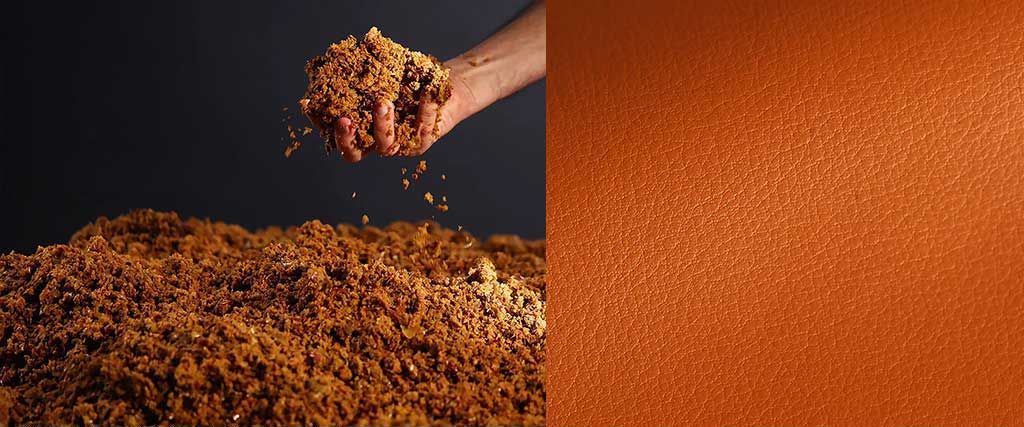
Left: Apple Slurry. Right: Finished apple leather. Images via dezeen.com
Apple leather is currently being produced by a few manufacturers, one being Frumat Leather, based in Florence, Italy. The production process Frumat Leather begins with gathering apples cultivated in Italy, drying them, and turning them into powder. The powder is mixed with pigments and a binder and spread onto a canvas until it turns into a leather-like material. Their method contains a minimum of 50% apple fiber. It is then combined with a polyurethane top layer.
Another prominent manufacturer is Beyond Leather, based in Copenhagen. Their plant-based leather alternative is called Leap. Leap is made by mixing apple waste (skins, cores, stems, and seeds) with natural rubber and applying it to a textile backing made of cotton and wood fiber. It is then finished with a protective coating.
The obvious negative of apple leather is the use of petroleum based coatings in the product. However, as a way to mitigate some of the impact, the fossil fuel derivative layer can be removed at the end of the product’s useful life. The apple layer itself can then be separated and is 100% biodegradable.
This non-animal leather requires 85% less CO2 in its production than traditional leather, and less than 1% of the amount of water needed for traditional leather, according to the manufacturer. It also reduces waste for apple juice manufacturers as more of the apple is able to be used.
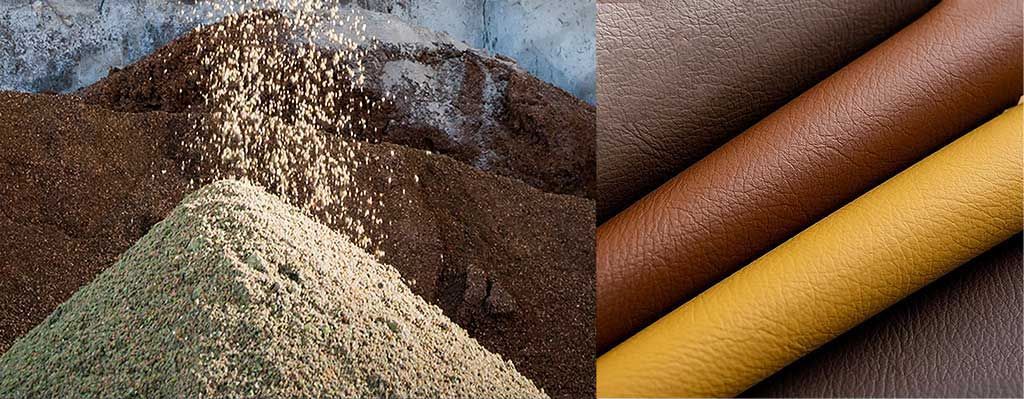
Left: Olive mill pomace. Right: Oleatex olive leather. Images via facebook.com/oleatex
Olive leather is a new and lesser known type of non-animal leather made from olive pomace, the pulpy material left behind after pressing olives. Olive pomace is the only waste in the olive oil production process. It is a combination of the olive’s skin, pulp, olive kernel, and pit or stone.
Oleago, a manufacturer of olive leather based in Turkey, calls their innovative leather Oleatex. The brand has been tight lipped about their manufacturing process, but it uses the olive pomace to create the new textile.
Companies like TexStudio are using olive leather to make belts, bags, pet products, and other accessories. The use of olive has environmental benefits as the trees grow quickly and can be grown in arid climates. They also require virtually no pesticides.
The manufacturing process uses fewer chemicals, and it is up to 70% plant based due to the use of water-based organic dyes. Olive waste has uses outside of the non-animal leather market as well. Olive leaves and pomace have been used as a tanning agent in vegetable tanning as an alternative to more toxic methods. While olive leather is not as strong as their PVC or PU counterparts, it is a noteworthy new competitor in the non-animal leather market.
Are non-animal leathers sustainable? To weigh the pros and cons, it must be considered that a majority of non-animal leathers contain fossil fuel derivatives, which make them non-biodegradable. These products must include these finishes in order to manufacture a quality goods that can effectively compete against synthetic leathers.
They have created a new category and methods to use materials previously thought of as waste. As of now, they are not as earth friendly as we are all hoping. They are, however, creating options that are not 100% synthetic leathers nor traditional leather. The average consumer does not have the ability to break down the material used in many of the leathers, so it is likely that they will never be reused or taken apart and recycled.
With sustainability, the ideal end result is a closed-loop cycle. Negatives aside, the current market of non-animal leathers are innovative and some companies have developed products that are completely biodegradable.
The most sustainable leather is leather you already own, or leather (traditional, synthetic, or non-animal) that already exists. Thinking conscientiously about leather purchases is the best way to buy for your own personal values and needs. Understanding what is available in the market, educating ourselves on how it is made, and what its post consumer life entails makes us, as the consumer, more able to make thoughtful purchases.
Everyone has their own perspective on what makes something sustainable so find the option that works best for you, whether that is buying animal leather secondhand, wearing synthetic leathers made from polyurethane, or searching for a non-animal alternative that best aligns with your specific values and needs.